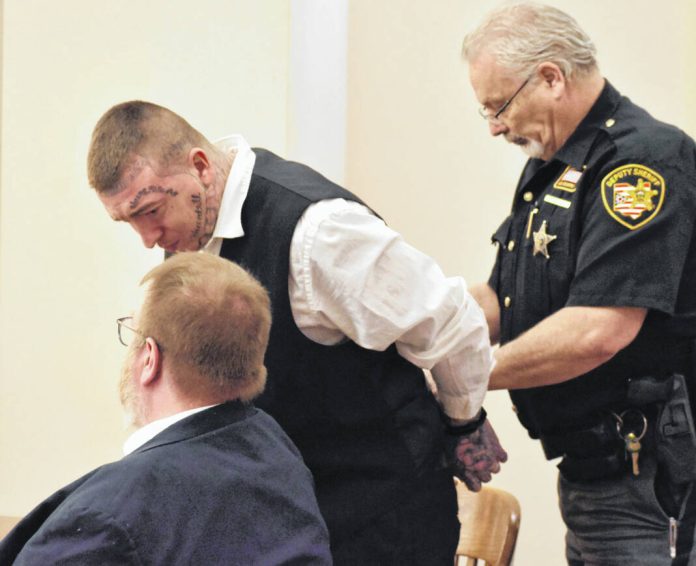LIMA — An Allen County jury on Thursday returned guilty verdicts against a Lima man charged with shooting at U.S. marshals and local law enforcement officers in July of last year.
Jurors deliberated for two hours before reaching their unanimous verdicts in the case of Carl Mollett, who was charged with five counts of felonious assault with firearm and repeat violent offender specifications, each felonies of the first degree, and two third-degree felony counts of having weapons under disability. The felonious assault counts included specifications for the use of a firearm when the victim was a peace officer and could add seven years of prison time for Mollett on each count when he is sentenced at a later date.
Mollett, 32, was alleged to have discharged a firearm in the direction of law enforcement personnel during a standoff on East Fourth Street in Lima last summer. Officers with the U.S. Marshal’s Service were attempting to serve an arrest warrant on Mollett for alleged sex offenses in Franklin County when, according to trial testimony from several witnesses, shots rang out from inside a residence owned by Mollett’s father.
Mollett held police at bay for several hours on the morning of July 28 by refusing commands to exit the home. The Lima man and his 19-year-old girlfriend, Amber Robertson, remained in the residence until tear gas canisters were deployed into the home by order of the commander of the Allen County SWAT team. Josh Bayer, the commander of the tactical unit at the time, testified Wednesday he decided to use tear gas after it was learned Mollett may be holding a hostage inside the home.
Shortly after the tear gas canisters were fired into the home Mollett and Roberston exited and were taken into custody without incident.
Edgar Mollett, the defendant’s father and owner of the Fourth Street home, testified Wednesday that a .22 caliber pistol, .22 caliber rifle, three 9mm handguns and an AR-15 style rifle were in the home when police arrived. Two of the handguns were seized by investigators but the weapon allegedly used to fire shots at officers was never located.
Taking the witness stand Thursday morning were two employees of the Ohio Bureau of Criminal Investigation. Lindsey Nelson-Rausch, a forensic scientist, said she was asked to perform DNA tests on two handguns — a Hi-Point 9mm pistol and a SCCY 9mm weapon — along with spent bullet casings. She testified that the level of DNA found on the items was insufficient for comparison to Mollett’s known DNA. A sample was taken from the SCCY pistol and was determined to come from an “unknown male who was not Carl Mollett,” the analyst said.
Alex Miller, a BCI firearm examiner, said it was determined that three spent shell casings and a fired bullet fragment turned over for analysis were not fired from either of the handguns submitted.
The state’s final witness was Allen County Sheriff’s Office Detective Kayla Rayl, who testified she was conducting an interview with Edgar Mollett as the standoff with his son was taking place. The elder Mollett was on the phone with his son and a member of the on-site Hostage Negotiation Team at the time.
Jurors viewed a video recording of that interview during which Carl Mollett told his father, “I’m going to smoke my last two cigarettes and then we’re coming out” of the house to surrender to authorities. A loud crash can then be heard on the video, along with the crying voice of Robertson. Rayl said the crash was the sound of a tear gas canister entering the home. Carl Mollett can then be heard saying, “Tell them to stop or I’m not coming out.”
On Wednesday a member of the Hostage Negotiation Team testified that Mollett earlier in the standoff had said that “people were going to die” if anyone attempted to enter the home. He also said he had shot at officers “because they kicked my door in.”
In his closing remarks to jurors, Steve Chamberlain of the Allen County Public Defenders Office said the state’s case was marked by “glaring holes.” Foremost, the defense attorney said, is the absence of a weapon.
“Where is that gun? The prosecutors suggest that it was hidden, which is sort of an insult to investigators. We don’t know that gun exists,” Chamberlain said. They have no gun, and that’s a big, gaping hole in their case.”
Jurors found the absence of a weapon to be no obstacle to returning their verdicts.







